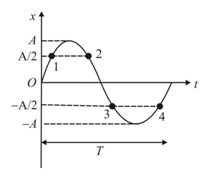Phase and Phase Difference in Simple Harmonic Motion
Important Questions on Phase and Phase Difference in Simple Harmonic Motion
Two particles and execute simple harmonic motion according to the equations and Find the phase difference between them.
Figure shows the displacement-time graph of a particle executing SHM with a time period Four points and are marked on the graph where the displacement is half that of the amplitude.

Identify the points where the particles move in the same direction. Find the time difference between them.
Figure shows the displacement-time graph of a particle executing SHM with a time period Four points and are marked on the graph where the displacement is half that of the amplitude.

Identify the points of same displacement but with opposite direction of motion. Find the time difference between them.
A particle of mass oscillates simple harmonically with angular frequency Find the phase of the particle at and Start calculating time when the particle moves up passing through the mean position.
A particle executes SHM with an amplitude and a frequency Assuming the particle to be at a displacement initially, in the positive direction, determine its displacement equation and the maximum velocity and acceleration.
A particle executes SHM with an angular frequency If it is at its extreme position initially, then find the instants when it is at a distance times its amplitude from the mean position.
Two particles move parallel to the -axis about the origin with same amplitude '’ and frequency . At a certain instant, they are found at a distance from the origin on opposite sides but their velocities are in the same direction. What is the phase difference between the two?
Two particles are executing simple harmonic motion of the same amplitude and frequency along the -axis. Their mean position is separated by distance . If the maximum separation between them is , the phase difference between their motion is
Two particles and describe SHM of same amplitude , same frequency along the same straight line. The maximum distance between the two particles is . The phase difference between the particles is:

